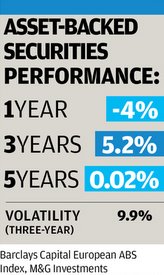M&G’s Bernard Abrahamsen argues that the long-term interest rate hedge of asset-backed securities makes it worth forgetting their sub-prime history, in this week’s Investment Blueprint
 Asset-backed securities (ABSs) could be the most misunderstood of fixed income investments.
Asset-backed securities (ABSs) could be the most misunderstood of fixed income investments.
Shunned by some for their complexity, lionised by others for their robustness, they can divide opinion.
For pension schemes, the best ABSs can be as secure as some AAA-rated government bonds.
The best securities offer an income stream that can help a pension scheme meet its liabilities and remain undented by massive falls in house prices, corporate defaults and other economic problems.
ABSs in their purest form are bonds issued by banks for funding reasons just like covered bonds or unsecured debt.
However, unlike many types of bank debt, an ABS offers its investors something much more secure – access to a ringfenced pool of assets that sits off the bank’s balance sheet.
If the bank fails, the asset holder gets an early claim on this collateral.
These assets are loans made by the bank and they come in four main asset types: residential mortgages, commercial mortgages, credit cards and car purchases.
Mortgage loans make up the vast majority of the ABS market.
These bonds usually also provide an income linked to interest rates – not bad at a time when rates sit at historic lows and pension funds are mindful that this will change at some stage.
How to use ABSs
Three points to consider on ABS
-
Understand which portion of the market you want exposure to.
-
Ensure your fund manager can analyse and rate the bonds properly.
-
Be clear about whether you want an ABS portfolio, ABSs within a broader credit portfolio or both.
Understanding these bonds can take time.
An investor in a residential mortgage-backed security (RMBS) issued by a UK high street bank must measure the bank’s stability and solvency, the underlying assets and the way in which these assets are structured.
They will tend to be grouped into tranches according to their credit rating – AAA, AA, BBB and so on.
These rankings come from credit ratings agencies but sensible investors will want to do their own analysis.
This may even include the creditworthiness of individual mortgage borrowers in the loan pool.
Analysing all that can be time-consuming. But sensible investors of pension fund money believe this effort is worth it.
If they can pinpoint the best bonds, they have something that is likely to survive a bank failure, corporate defaults spiking to unprecedented levels, house prices falling by half and widespread borrower defaults in the mortgage repayment pool.
At the same time, it will still ensure the investor will receive their principal back and their income stream – not every fixed income asset can claim that.
Managing known risks
The worst ABSs do not have such a good track record.
In the run-up to the credit crunch many investors piled into US sub-prime mortgage-backed bonds.
There were confident in the attractive ratings bestowed on them by ratings agencies without looking too closely at the underlying loans.
You need bonds that can pay you back and that can help you hedge rises in interest rates
When these sub-prime mortgage borrowers started to fall behind on their payments from around 2007, and when some bonds started to fail, many investors marked the whole ABS sector as tainted.
They dropped all their holdings regardless of credit quality.
Investors even shunned European ABSs despite Europe’s markets displaying few of these issues.
Those who could identify securities issued by stable institutions and with good quality collateral could pick them up remarkably cheaply.
In some cases these bonds were beaten down to 40p or 50p in the pound. It really was a once-in-a-lifetime investment opportunity.
Capital values on these better ABSs have pretty much returned to par but when pension schemes need secure income streams to match their liabilities, the argument for holding them persists.
In an uncertain world where economic, political and market volatility have become the norm, and when a UK 10-year gilt yields little over 2%, you need bonds that can pay you back and help you hedge rises in interest rates.
When some of the most robust UK RMBSs offer yields to maturity of around 4-7%, there is a strong argument to build exposure, provided you can sort the wheat from the chaff.
Bernard Abrahamsen is head of institutional distribution at M&G Investments






















